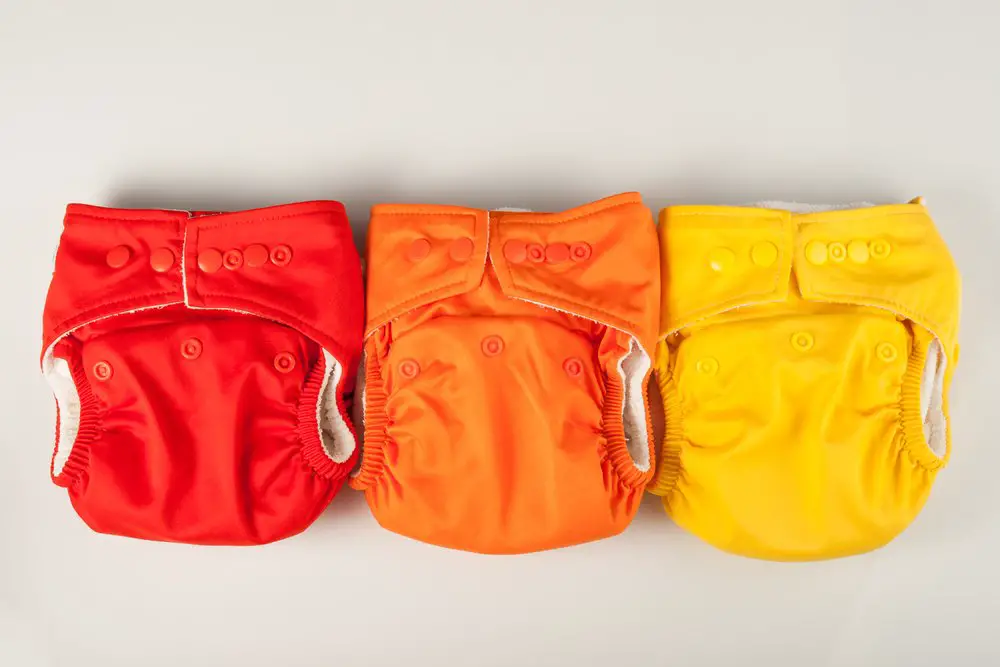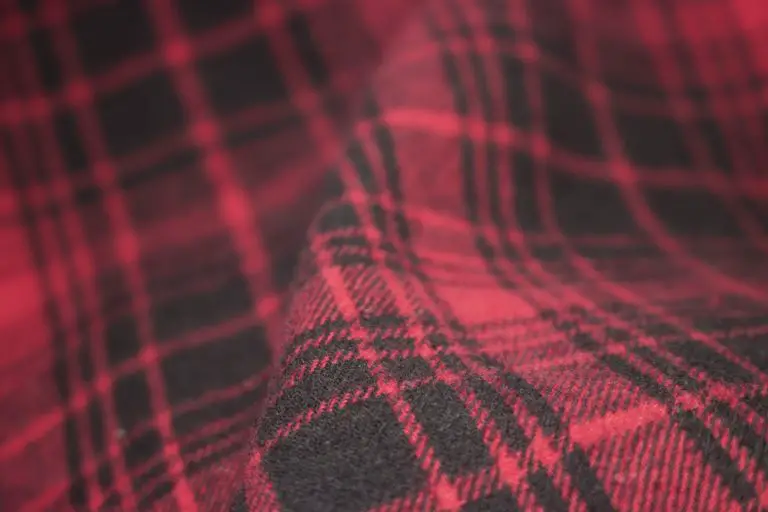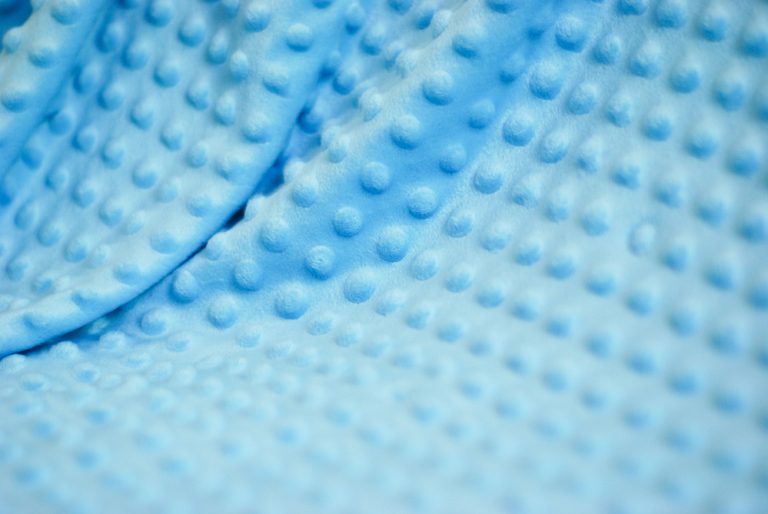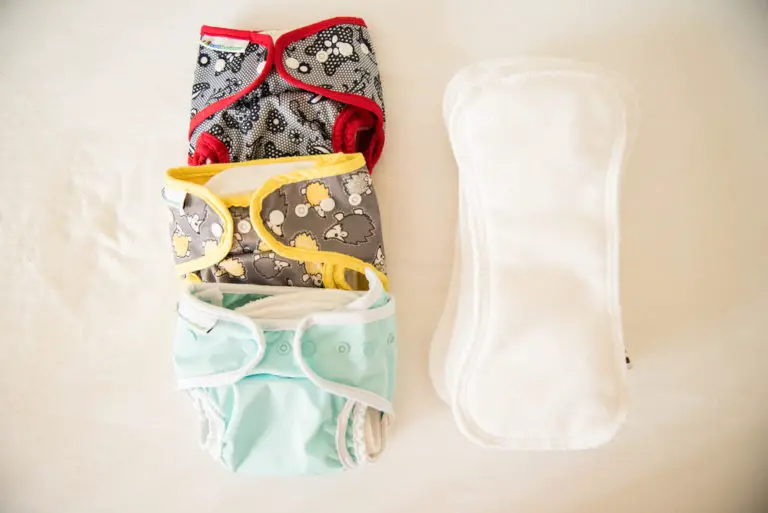10 Types of Cloth Diapers: Comparison Guide (2024)

If you are just getting started with cloth diapering, you may not realize there are several types of cloth diapers. Depending on your needs, one style may work better for you than others.
If you want to cut down on dry time, then pre-folded diapers with covers are a great option. If fewer steps interest you, then all-in-ones will cut down on the process.
There is a lot to learn about cloth diapers, and this guide is here to help! I will walk you through the various types and pros and cons of each to help you make the most informed decision.
- All-in-One Diapers
- All-in-Two (Hybrid)
- Pocket Diapers
- Fitted Diapers
- Contoured Diapers
- Flats
- Prefolds
- Swim Diapers
- Inserts
- Covers
- Closures
- Diaper Sizes
Types of Cloth Diapers
This article will walk you through eight different cloth diaper types: all-in-ones, all-in-two, pocket, fitted, contoured, flat, pre-fold, and swim diapers.
All-in-one, all-in-two, and pocket diapers have the least number of steps and may be best if you will use reusable diapers in childcare. Flat and prefolds dry the fastest and also are great for preventing leaks.
Swim diapers are exactly what they sound like, used for swimming but are not suitable for daily wear as they lack absorbency.
Hang on tight and take some notes as we delve into all the types of diapers out there! Use the table below as a quick reference guide as you read along.
| All-in-one | All-in-two | Fitted | Contoured | Flat | Prefold | Swim | ||
| Good | Easy to wash, similar to disposable diapers | Easy to wash. Cute designs. | Snap in place & adjustable. Less dry time. | Easy to Use. | Fit baby snuggly | Quick Dry time. Inexpensive. | Quick Dry time. Inexpensive. | Using at the beach or pool. |
| Bad | Longer dry time. More expensive. | More Expensive. | Multiple pieces. | Multiple pieces. | Have to fit the baby’s size and shape. | Most complicated to figure out. | Have to fit the baby’s size and shape. | Leak a lot. |
| Price | $15-$25 per diaper | $15-$25 per diaper + liner | $15-$20 per diaper + liner | $10-$20 per diaper + cover | $5-$8 + cover | $1-$3 + cover | $1-$3 + cover | $10-$15 |
| Drying | 24 hours | 12-24 hours | 12 or less | 12 or less | 12 or less | 6 or less | 6 or less | 6 or less |
| No. of pieces | 1 piece | 2 pieces | 2 pieces | 2 pieces | 2 pieces | 2 pieces | 2 pieces | 1 piece |
| Absorbing layer | Built-in | Attaches | Insert | Fitted piece | Contoured Piece | Flat piece | Pre Folded piece | Built-in |
| Fastener | Snaps | Snaps or hook and eye | Snaps | Snaps | Pins or fasteners | Pins or fasteners | Pins or fasteners | Snaps or Velcro |
| Best for | Beginners, Busy parents, use for daycare | Those on the go. | People who need a quicker dry time. | Beginners. | Those who want a cost effective situation | Those on a budget. | Those on a budget. | Use in the water. |
| Difficulty | Easy to use | Easy to use | Fairly Easy | Fairly easy. | More difficult | Most difficult. | More difficult | Easy |
All-in-One Diapers
All-in-one diapers are exactly what they sound like, one-piece diapers. This diaper style has a built-in absorbency layer which makes cleaning and washing them simple. Simply clean out the poop and place it in the diaper pail until it is time to wash.
These diapers are best for those who enjoy simplicity without a lot of moving parts. All-in-one cloth diapers are the most likely to be accepted for use by childcare centers.
Best AIOs also tend to be the most expensive, but the price has decreased significantly in the past decade. On average, you can get a set of 5 for about $100.
Absorbing Layer
The absorbing layer for all-in-ones is attached to the diaper fabric. Of all the cloth diaper types, this style is the only one that has this feature.
Because the diaper insert is built in, these are the thickest style and therefore take the longest to dry. Cloth diapers should air dry, so if you decide to use all-in-ones, be sure to have enough to have clean, dry ones on hand.
Pros
- Easy to use, all one piece
- Childcare is more likely to accept them
- Simple to wash and clean
Cons
- Most expensive to purchase
- They take the longest to dry
- You need a lot of them
- Not great for nighttime
Price: More Expensive $100 for a set of 5
Best for: First-time users, use in childcare
Drying: long dry time, 24-hour+
Fastener: Snaps
No. of pieces: One
Difficulty level: Easy
All-in-Two (AI2 or Hybrid)
Hybrid cloth diapers are a two-piece diaper system that involves an absorbent soaker that attaches to a waterproof liner. Hybrid cloth diaper covers detach from the diaper liner for washing.
One of the benefits of this style is that typically your baby can wear the outer shell two or three times before they need to be washed. Hybrid diapers have both the snap option and hook-and-eye closure system, depending on the brand you choose to use.
Best hybrid cloth diaper systems are roughly $15-$25 for the diaper plus insert.
Many people use a disposable cloth diaper insert which makes hybrids an excellent option for people who are out and about a lot.
Absorbing Layer
The absorbing layer in a hybrid is detachable and washable, which cuts down on the dry time.
This is one of the diaper systems that parents choose to use a biodegradable liner with. The disposable liner makes clean-up a cinch since you can flush them or toss them out.
Pros
- Easy to use 2-piece system
- Snap-on and adjustable
- Simple to wash and clean
- Disposable liners are an option
- Parents can use the outer shell a few times
Cons
- Expensive start-up cost
- Dry time can still be lengthy
- Tend to leak at night
Price: $15-$25 per diaper + insert
Best for: People on the go
Drying: long dry time, 12+ hours
Fastener: Snaps or hook and eye
No. of pieces: Two
Difficulty level: Easy
Pocket Diapers
Of all the cloth diaper styles, pocket diapers are the ones I am most familiar with since they are the kind I used for my son. These cloth diapers snap into place and are adjustable based on your baby’s size, just like AIOs and hybrids.
Best pocket diapers use absorbent diaper inserts that slide into a prebuilt pocket in the crotch area of the diaper. Because of the absorbent layer, cloth pocket diapers dry much faster than All-in-ones or hybrids.
Parents must change the outer shell each time, making these not the best option for people who go out a lot because they require so many pieces.
Absorbing Layer
The absorbing layer of pocket diapers is removable and washable. Because the insert is placed inside a pocket, the diaper’s shell must be washed each time.
The shell of the diaper’s fabric is also soft and slightly absorbent but not enough to use without the cloth diaper inserts.
Pros
- Easy to use 2-piece system
- Snap-on and adjustable
- Shorter dry time – 12 hours or less
Cons
- May need to use multiple inserts
- Tend to leak at night
- Bulky
Price: More affordable $15-$20
Best for: People who need short dry time
Drying: less than 12 hours
Fastener: Snaps
No. of pieces: Two
Difficulty level: Fairly Easy
Fitted Diapers
There are many different types of cloth diapers, but fitted diapers are great! They are especially good for those who want to avoid fasteners and pins because they snap on like a traditional disposable diaper.
Fitted cloth diapers are great for people who want a reasonably simple system. They are easy to adjust as your baby grows and are excellent at preventing leaks.
The cloth portion is the absorbent layer, so you will need a waterproof cover of all the reusable diapers; this is an excellent system for those who like simplicity and who are on a budget.
Absorbing Layer
The absorbing layer is basically a cloth diaper with snaps. You will need to purchase waterproof covers to go over the absorbing layer, and you may even need to add boosters, which are an extra layer of absorbency.
The fitted cloth diaper is a fairly easy cloth diaper for beginners despite it being a two-piece system.
Pros
- Inexpensive option
- Shorter dry time – 12 hours or less
- You can use the cover several times
- They leak less than other types
- Adjustable
Cons
- Two-piece system
- The Baby’s entire bottom becomes wet
- May need to purchase a booster
Price: Affordable, $10-$20 per diaper
Best for: People who want an easy system
Drying: less than 12 hours
Fastener: Snaps
No. of pieces: Two
Difficulty level: Fairly easy
Contoured Diapers
Contoured diapers are one of the cheapest cloth diaper options. Contours are similar to pre-folds and old-fashioned cloth diapers in that you need to shape them around your baby. What makes them a little easier than pre-folds is that they come contoured into an hourglass shape that cuts down on the folding.
Contours are typically one-size cloth diapers that you will adjust. You will also need to purchase a waterproof cover to go over the cloth diapering fabric. Covers are an additional cost, but babies can wear each cover several times before needing to be washed.
Absorbing Layer
The contoured fabric piece that is considered the diaper is also the absorbing layer. Parents must change this type of cloth diaper insert each time because it is what absorbs all liquid.
The cloth diapering fabric used for contours is typically cotton. The covers come in a variety of water-resistant fabrics such as hemp, bamboo, and even wool.
Pros
- Inexpensive option
- Shorter dry time – 12 hours or less
- You can use the cover several times
- They leak less than other types
Cons
- Two-piece system
- Have to pin them yourselves
- Not as easy for others to learn/use
Price: Affordable, $10-$15 per diaper
Best for: People who want a cost-effective system
Drying: less than 12 hours
Fastener: Fasteners or pins
No. of pieces: Two
Difficulty level: Fairly easy
Flats
Of all the different kinds of cloth diapers, flats are most similar to traditional cloth diaper systems. Flats are loose pieces of fabric you need to fold and shape around your baby’s bottom. Similar to contours, you will need to fasten or pin these diapers yourself.
Best flat diapers are the least expensive of all types of cloth diapers, and they also have the quickest dry time. You will need to purchase waterproof covers to place over the secured diapers.
Unless your baby has a blowout or it begins to smell, babies can wear covers through several diaper changes.
Absorbing Layer
The absorbing layer of a flat diaper is the rectangular piece of fabric you fold around your baby. The fabric is made of natural fibers like cotton, wool, bamboo, or hemp.
Not only are these types of fabric naturally absorbent, but they are breathable as well, which is excellent for your baby’s bottom!
Pros
- Least expensive option
- Quickest dry time – less than 6 hours outside
- You can use the cover several times
- Natural fibers are breathable
- They can be used as burp cloths
Cons
- Two-piece system
- Have to pin them yourselves
- Not as easy for others to learn/use
Price: Affordable, $1-$3
Best for: People on a budget
Drying: less than 6 hours
Fastener: Pins or fasteners
No. of pieces: Two
Difficulty level: Most complicated
Prefolds
Prefolds are rectangular pieces of fabric with a padded section in the middle. The padded section is the part that covers your baby’s bottom. Similar to contours, you will need to fasten or pin these diapers yourself.
If you are making a cloth diaper comparison among the less expensive options, best prefolds are a good marriage of cost and usability.
They need to be fitted and fastened around your baby, but the padded, pre-folded section makes them easier to use than flats. They are slightly less expensive than contours but still provide the same level of protection when fastened correctly.
Absorbing Layer
The pre-folded padded diaper is the absorbing layer of this style of cloth diaper. They are usually made of a natural and absorbent fabric such as cotton, hemp, or bamboo.
Since prefolds are so absorbent, they are a great nighttime option. The natural absorbency wicks moisture away from your baby’s bottom. You will need to use a waterproof cover over the absorbent layer.
Pros
- Least expensive option
- Quick-dry time – less than 6 hours outside
- You can use the cover several times
- Natural fibers are breathable
- Great at night
Cons
- Two-piece system
- Have to pin them yourselves
- Not as easy for others to learn/use
Price: Affordable, $1-$3
Best for: People on a budget
Drying: less than 6 hours
Fastener: Pins or fasteners
No. of pieces: Two
Difficulty level: Fairly complicated
Swim Diapers
We’ve been covering all the different cloth diapers, and now we’ve reached swim diapers! You can’t compare swim diapers to other types of non-disposable diapers because they serve a unique function. Nevertheless, we will briefly go over what they are, how they are used, and the pros and cons.
If you plan to take your baby into a public pool or to the beach, you will need a swim diaper. Parents cannot use regular diapers in the water as their goal is to absorb moisture. A swim diaper offers a protective layer if your baby goes potty but is not meant to absorb.
Absorbing Layer
The absorbing later in the swim diaper is very thin and not meant to hold a lot of liquid, but it will do the trick to prevent your little one from leaking into the pool water. The absorbing layer and the diaper’s outer shell are attached, so they will need to be washed with each change.
Pros
- Great for swimming
- UPF 50+
- Lightweight
Cons
- Thin and not absorbent
- You need to own a few
- Only for use when swimming
Price: Affordable $10-$15
Best for: Use in water
Drying: less than 6 hours
Fastener: Snaps or velcro
No. of pieces: 1
Difficulty level: Easy
Inserts
There are many cloth diaper insert types. Depending on your cloth diaper of choice or fabric preferences, you may like one over the other. They are made of fabrics such as cotton, hemp, bamboo, microfiber, and disposable inserts.
Cotton
Cotton is a super soft and natural fiber to use in your cloth diapers. They absorb liquid quickly, and they don’t leak very much. Cotton also has a high liquid capacity, so they hold a lot! Parents can place cotton directly next to your baby’s bottom. As a bonus, it is very cost-effective!
Bamboo
Bamboo is an excellent material because it is environmentally friendly and very soft against your baby’s skin. Bamboo inserts are relatively inexpensive and hold a lot of liquid. Bamboo is slower to absorb than most of the other types of inserts. You can pair a slower-to-absorb insert with a quicker one for maximum absorbency and capacity.
Charcoal Bamboo (CB)
Charcoal bamboo inserts typically have a microfiber core. The darker fabric helps prevent visible stains and is very soft. Charcoal bamboo inserts are the middle of the line for the cost, absorbency, and capacity. Usually, a small and large charcoal liner layered together is adequate for an overnight.
Microfiber
Microfiber inserts were the kind I used with my baby’s pocket diapers. Microfiber cannot be placed directly against your baby’s skin, so it is best for use in pocket diapers or with another type of liner on top. They are very durable and can survive lots of washes! They tend to be the most affordable option and absorb very quickly!
Hemp
Hemp or hemp-cotton blend inserts rarely leak and have a high liquid capacity. Hemp inserts tend to be the most expensive type of insert, so you may want to combine them with another less expensive insert. You have to wash them several times before they are ready for use, and they are very delicate.
Disposable Inserts
Disposable liners are great when you are out on the go or used in a child care setting. They make cleaning up poop a cinch since they are biodegradable and can be flushed or tossed away. I used disposable liners and loved them. They are often made of bamboo, which is very durable and an excellent sustainable resource.
Covers
As you complete your diaper comparison, consider that some diapers need covers. There are as many types of covers as their inserts. There are cloth diapers with snap inserts, some with pockets, and lastly, some that simply lay in place.
PUL
PUL is a fabric treatment that in effect laminates the fabric, making it water-resistant. PUL can be used on a variety of fabric types, including cotton, polyester, or blends. PULs are considered very safe but are not very breathable, so you may want to combine them with a natural fiber insert.
TPU
TPU is the film used to create PUL. TPU stands for Thermoplastic Polyurethane. This means that PUL and TPU are not two different entities but, in fact, part of the same. Companies use the terms to make it seem like two different products for the purpose of marketing.
Wool
Wool is a great natural fiber that is not only breathable but extremely absorbent and water-resistant. Wool diaper covers come in so many adorable colors and patterns. If you know how to knit, you can make your own which makes them even more cost-effective!
Fleece
Fleece diaper covers are incredibly soft and gentle against the baby’s skin. Fleece creates air circulation, which helps prevent diaper rash. For people who prefer not to use animal products, fleece is an excellent alternative to wool diaper covers. They are also less expensive than wool covers, so they are great for clothes diapering on a budget.
Closures (fasteners)
There are different types of closures for cloth diapers. Some cloth diapers snap, some Velcro, and others use safety pins. The most common type is snaps but styles like prefolds, contours, and flats all use safety pins.
Snaps
All-in-ones, hybrids, pocket diapers all traditionally use snaps. Snaps are great because they are easy to adjust as your baby grows and easy to take on and off. The one downside to snaps is that they can wear out with repeated use, especially if you do not have many diapers in rotation. Snaps are also more difficult for children to take off and on themselves when they are potty training.
Velcro
Velcro is an easy option for parents whose baby is in between cloth diaper sizes. Velcro fasteners are easy to adjust and relatively easy for children to take on or off themselves. A downside to Velcro is that it can get caught on other fabrics and snag in the wash.
Safety Pins
If you decide to use prefolds, flats, or contours, you will need to fasten them yourselves. The most common fastener method is safety pins. Typically you don’t use regular safety pins. Instead, there are safety pins made especially for cloth diapers. These fasteners usually have a protective plastic layer on the ends so that your baby doesn’t accidentally get pinched.
Diaper Sizes
There are various sizes of cloth diapers to consider when looking into cloth diapering. Newborn, small, medium, large, and one-size. One size is the most versatile but read our descriptions below to decide which is best for you.
Newborn
Newborn diapers are exactly what they sound like; they are diapers sized for newborns. Newborn diapers typically only fit babies up to 10lbs. My oldest son only wore them for about two weeks, and my second was born at 10lbs, so I never used them! If you do decide to use them, I recommend that you don’t purchase too many.
Sized Diapers
Sized diapers come in small, medium, and large. Sizes may vary by manufacturer, but typically, a small is for sizes 10-17lbs, medium 17lbs – 27lbs, and large is for 27lbs plus. Check with the brand you plan on buying for their actual sizing recommendations. Some companies make XL as well for children over 35 pounds.
One Size Diapers (OS)
One-size diapers are likely the most economical choice as they typically fit babies from 10lbs through toddlerhood. They have rows of snaps or velcro fasteners as well as adjustable elastic bands in the legs. As your baby grows, you will need to adjust the sizing, and the elastic can wear out over time; however, it is also replaceable.
FAQ
Which type of cloth diaper is best?
That is really a personal choice but the most versatile type is the one-size. When properly cared for a set of one-size diapers can last the life-cycle of your child’s diapering years.
What are the easiest cloth diapers to use?
All-in-ones are the simplest because there is only one piece to put on and off your baby. They take the longest to dry but that is their only major downside.
Do you really save money using cloth diapers?
Yes, you can! Disposables will cost roughly $2,000-$3,000 from birth to three. A full set of cloth diapers can be as little as $300, although more realistically $500-$800.
What is all in 2 cloth diapers?
All in 2 cloth diapers are also known as hybrids. They have an inner layer that attaches into the outer waterproof shell.
How many inserts do you need for cloth diapers?
You should probably have twice as many inserts as you have diapers. To increase absorbency at night you may need to use two or three at a time.
How long do cloth diapers last?
Cloth diapers can last several years, even through two kids if properly cared for. It will help your cloth diapers last longer the more you have.
Do cloth diapers work overnight?
Yes, they can, but you will likely need to add additional inserts to help at night. Certain styles work better at night time than others.
How do you clean poop out of cloth diapers?
You can scrape the poop into the toilet with a spatula or similar device or use a water sprayer attachment that is hooked up to your toilet.

L. Elizabeth Forry
L. Elizabeth Forry is an Early Childhood Educator with fifteen years of classroom teaching experience. She earned a Master of Science in Early Childhood Education from The University of North Dakota and has a Bachelor of Arts in English and one in Music from Lebanon Valley College. She has taught children in Japan, Washington D.C., Chicago, and suburban Maryland. She is trained as a reading therapist, has a TEFL certification, and has done extensive work with children regarding mental health, social-emotional development, and gender development. She has written curriculum for children and educators and has led training sessions for parents and educators on various topics on early childhood development. She is the mother of two boys and resides outside of Annapolis, Maryland.






